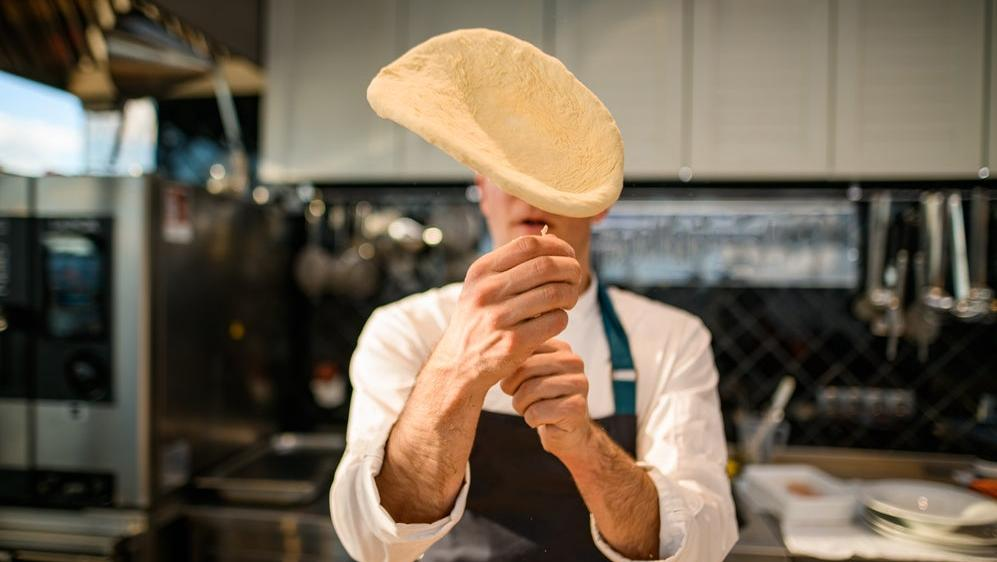How To Throw Pizza Dough Like A Pro
Learn to toss dough with this clever practice tool.
We may receive a commission on purchases made from links.
As many readers know, I'm a (mostly) former pizzamaker. One of the things people always liked to ask me was if I knew how to toss pizza dough in the air, like you see in movies and at some famed pizzerias. Paulie Giannone, founder of Paulie Gee's pizzeria (I worked at Paulie Gee's Logan Square, in Chicago), generally discouraged the practice. "Throw is for show," he'd say. I still did it anyway.
In short, yes, I can toss a dough up in the air, though I'm not particularly great at it. Some of my coworkers were absolutely amazing at a toss, which always delighted kids and adults alike, since the restaurant has an open kitchen. Travis and Danny, two of my former coworkers, have a particular knack for it; Travis always gets some really impressive airtime with his, while Danny mastered a rotational speed that always blows my mind.
The pros and cons of tossing pizza dough
Paulie is right, though: for the most part, throwing isn't a great way to stretch out pizza dough. With softer types of dough, like the Neapolitan-style I frequently dealt with, you run a real risk of poking holes in it when you throw it around. That renders the dough useless during a fast-paced service—and since we cold-fermented the dough in a process that took three days, it was obviously a big waste if we punctured or dropped it.
During slower services, fidgety pizzamakers do like to practice their toss without using restaurant resources. One way we'd practice was by using wet kitchen towels, which have the approximate heft of dough, but it'd have to be the right level of wet. If it was too soggy, it'd spray water everywhere (and onto your coworkers), but if it was too dry, the towel would float around inconsistently and be hard to handle.
There is, however, a specific tool for practice—essentially a toy—called a Throw Dough. It's exactly what it sounds like: a simulated pizza crust made of silicone that roughly mimics the texture and weight of raw pizza dough. Its edges are ridged to reflect that of an actual pizza crust as well, so the weight is distributed like the real thing.
These tools are fun, and you can get them online. Amazon sells a 13" round for $37, or you can get a similar 13" one through the U.S. Pizza Team's online store for $25, if you want to learn how to throw pizza dough at home. I have to warn you that they are a little delicate; if you use your fingertips a lot to keep poking the thing up in midair, you run the risk of puncturing it. (Another way in which these things are realistic.)
How to throw pizza dough like a pro
I am not the most coordinated person, but here's one thing I know for sure: The launch is really important. Travis always likens it to throwing a layup with a basketball. You want to use the palm of your dominant hand with a slight bit of fingertip to toss the dough up into the air, flicking your wrist sharply (like you're spinning a basketball for a layup). The dough has to be parallel to the ground when it takes flight; any angles will make it harder to recapture on its descent, or will make it more challenging to keep up in the air if you're planning on bouncing it back up.
On its way down, you can either let the dough land on the back of your knuckles, poke at it extremely gently with your fingertips (a maneuver that's only ideal with a Throw Dough), or use the palm of your hand for a re-launch to keep the fun going. A real dough will quickly stretch out to comical proportions, and if you're good, these things can become paper thin and absolutely enormous. Eventually it will tear, at which point you may or may not cry. A Throw Dough, obviously, won't get any bigger since it's made of silicone, but you get infinite tosses from it—or at least theoretically, because they do eventually break down from wear and tear.
Honestly, tossing pizza dough is as fun as it sounds. At home, dough is more of a precious resource since it's probably destined for dinner, so I really don't recommend it as a home cooking technique. But if you want to try tossing dough without the loss of a meal, get yourself a practice version to fidget with. And if you don't have high ceilings, I highly recommend you only practice outside, because at the beginning, disaster is inevitable. With practice, you'll look like a master pizzaiolo and have a really specific party trick to show your friends. Or you can get a job at a pizzeria, like I did.
